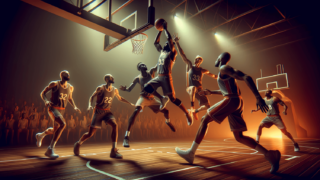
What Is Pivoting in Basketball?
Written by: Basketball Universe
Last updated:

When it comes to basketball, there’s more to the game than just scoring points and showing off your slam-dunk skills. For those eager to enhance their court knowledge and step up their game, pivoting in basketball is a critical aspect worth mastering. In this fun yet professional blog post, we’ll dive deep into the art of pivoting, exploring its fundamentals, rules, and techniques. Discover how this seemingly simple maneuver can work wonders for your game, opening the door to new strategic possibilities and an unrivaled level of on-court finesse.
What Is Pivoting in Basketball?
Pivoting in basketball is a fundamental skill that involves a player keeping one foot, known as the pivot foot, stationary on the ground while moving the other foot in any direction. It allows players to protect the ball, improve their positioning, and create passing or shooting opportunities without violating the traveling rule.
The Importance of Pivoting in Basketball
Pivoting is a versatile tool that grants players the ability to easily navigate the court, protect possession, and make smart decisions during gameplay. It enables better ball handling, setting up plays, passing, and shooting. By mastering the art of pivoting, players can create space, maintain control, and effectively outmaneuver opponents. Let’s delve into the pivotal aspects of this essential basketball maneuver.
The Fundamentals of a Good Basketball Pivot
Establishing the Pivot Foot
First and foremost, identify your pivot foot, which is crucial to performing a legally executed pivot. Upon receiving the ball, note the foot that is planted on the floor; this is your pivot foot. If you’re right-handed, your left foot typically acts as your pivot, and vice versa for left-handed players. However, as you progress in your basketball journey, it’s essential to develop ambidexterity in your footwork, granting a major competitive edge.
Controlling the Pivoting Movement
Controlled movement is key to an efficient pivot. When pivoting, ensure you keep your back straight, knees bent, and stay low for proper balance. Your non-pivot foot should move in a fluid and controlled manner, with the toes pointing outward to maximize your range of motion. Practicing these fundamentals will seamlessly integrate pivoting into your skillset both offensively and defensively.
Types of Basketball Pivots
Forward Pivot
The forward pivot is executed by moving your non-pivot foot forward, turning your body to face the basket as you step. This pivot is often employed when facing the basket to create shots or to open up passing lanes. A key tip for a successful forward pivot is to maintain low and wide stances, ensuring stability and optimum space creation.
Reverse Pivot
In a reverse pivot, the non-pivot foot moves backward as you spin in the opposite direction. This move is effective for protecting and shielding the ball from opponents, while also opening up opportunities for passes or drives to the basket. To achieve an effective reverse pivot, remember to keep a stable center of gravity and maintain a low stance throughout the movement.
Drop Step Pivot
The drop step pivot is a quick move used primarily in post play, allowing players to gain a strategic advantage when positioning close to the basket. To perform a drop step pivot, move your non-pivot foot back and drop it towards the baseline, creating space between you and your defender. This move is great for quickly establishing strong post positions and creating easy scoring opportunities.
Basketball Pivoting Drills and Exercises
Pivot-to-Pass Drill
This exercise focuses on developing pivoting accuracy and proficiency in passing. Position yourself at the elbows or on the wings, have a partner feed you the ball, and execute a pivot towards the basket. Then, make a pass back to your partner. Alternate between forward and reverse pivots for several repetitions, gradually increasing your speed as you become more comfortable and fluid.
Pivot-to-Shoot Drill
Enhance your ability to pivot and shoot with this simple drill. Position yourself at various spots around the key, receive a pass from a partner, and perform a forward or reverse pivot. Transition directly into your shooting motion and build up your accuracy and footwork over time. Rotate through different spots on the court to diversify your practice and skillset.
Mirror Pivoting Drill
This drill helps players master pivoting movements in a dynamic, defense-focused setting. Pair up with a partner, with one player holding a ball as the offensive player, and the other acting as defense. The offensive player should pivot to shield the ball, mirroring their movements according to the defender, attempting to maintain control and space. Perform this drill for several repetitions before switching roles with your partner.
Common Pivoting Mistakes
Lifting the Pivot Foot Too Early
A common mistake in basketball pivoting is lifting the pivot foot prior to releasing a dribble, pass, or shot. This results in a traveling violation, turning possession over to the opposing team. Ensure you release the ball before your pivot foot leaves the floor to avoid this costly mistake.
Inconsistent Footwork
Many players struggle to maintain consistency with their pivot foot, frequently alternating between feet. Consistently using the wrong pivot foot can lead to turnovers and missed opportunities. To avoid this, diligently practice footwork and firmly establish the appropriate pivot foot upon receiving the ball.
Improper Body Positioning
Struggling to maintain proper body positioning during a pivot is another common stumbling block for many basketball players. This often manifests as poor balance, a raised center of gravity, or a narrow stance. Revisit the fundamentals and focus on low, balanced stances with controlled movements to overcome poor body positioning in pivots.
Pivoting Strategies for Different Basketball Positions
Guard Pivoting Strategies
As the primary ball handlers and playmakers, guards should embrace their agility, speed, and quick decision-making abilities when implementing pivoting in their game. Pivoting to create space to execute passes or drives, and employing the drop step pivot to navigate opponents are skills that will immensely benefit a point or shooting guard’s game.
Forward Pivoting Strategies
For forwards, pivoting is vital in both offense and defense. Utilize forward and reverse pivots to protect the ball, create shooting opportunities, or identify open teammates for passes. Post players, such as power forwards or centers, should master the drop step pivot, maximizing their prowess in post play and increasing their scoring capacity.
Wing Pivoting Strategies
Wings benefit tremendously from a well-executed pivot. Small forwards or wings need to have a versatile game, pivoting to create space on offense, optimizing opportunities for teammate passes, and shooting over defenders. Implementing both forward and reverse pivots in your offensive repertoire will elevate your effectiveness as a wing player.
Basketball pivoting is a fundamental skill that should never be overlooked. By dedicating time and effort to developing this ability, you will refine your gameplay, unlock strategic advantages, and become a versatile force on the court.
Effective Pivoting in Game Situations
Being proficient in basketball pivoting is not only about mastering its various forms and techniques but also knowing when and how to apply them during a game. In this section, we’ll look at how you can effectively use pivoting in several game situations to maximize your offensive and defensive capabilities.
Offensive Pivoting Strategies
Triple Threat Scenarios
Upon receiving the ball on offense, pivoting into a triple threat position is fundamental. Position your feet in a low, balanced stance that allows you to easily pass, shoot, or dribble. The triple threat grants the option to transition into different offensive moves swiftly, holding the advantage over defenders.
Creating Passing Lanes
Pivoting can create efficient passing lanes for teammates, increasing scoring chances. When faced with a tight defense or double-team, utilizing reverse or forward pivots can generate space to locate and pass the ball to open teammates, initiating offensive plays and capitalizing on scoring opportunities.
Drive Initiation
Initiating a strong, successful drive to the basket can be facilitated by effective pivoting. A well-executed pivot can give you the space and create the angle needed to blow by a defender, opening a clear path to the hoop. Utilize the forward pivot or drop step pivot to initiate drives and contribute to your team’s offensive effort.
Defensive Pivoting Strategies
Quick Recovery
In a defensive capacity, pivoting can play an essential role in rapid recovery, especially after a missed block or steal attempt. Efficiently pivoting your body and feet can help you regain defensive position faster, contesting shots or limiting the opposing player’s driving lane to the basket.
Denying Passing Lanes
When playing off-the-ball defense, leverage pivoting to maintain a stance that denies open passing lanes to your assigned opponent. By constantly adjusting your body position through small, controlled pivots, you can effectively deter opponents from receiving an open pass and decrease the likelihood of a scoring attempt.
Defending the Post
While defending post players, pivoting becomes crucial. Employ the reverse pivot when fronting the offensive player to maintain a position that denies the entry pass while staying ready to contest their shot or dribble penetration. When playing behind the offensive post player, practice dropping your foot back into a ready stance to contest the shot or prevent a drive.
Pivoting, though often overlooked, is indispensable in basketball. Acquiring proficiency in pivoting techniques and their application in game situations will result in an elevated level of performance, making you a formidable presence on the court.
FAQ Section: Pivoting in Basketball
In this helpful FAQ section, we address some of the most common questions related to pivoting in basketball, further clarifying this pivotal skill and its practical applications on the court.
1. Is pivoting considered traveling in basketball?
No, pivoting is not considered traveling, as long as the player maintains their pivot foot on the ground and doesn’t change it until they have released the ball, either through a pass, dribble, or shot.
2. Can you pivot with both feet in basketball?
No, you cannot pivot with both feet. A player must choose one foot to act as the pivot foot, keeping it stationary throughout the pivot action, while the other foot is free to move in any direction.
3. Can you pivot after dribbling?
Yes, you can pivot after dribbling, as long as you come to a complete stop with both feet on the ground. In this case, the foot that touches the ground first becomes your pivot foot.
4. Can you lift your pivot foot while dribbling?
You cannot lift your pivot foot before initiating your dribble. To start a dribble, you must first release the ball towards the ground before lifting your pivot foot, or else you’ll be called for traveling.
5. Can a pivot foot be re-established after a jump stop?
No, a pivot foot cannot be re-established after a jump stop. After coming to a complete stop during a jump stop, both feet are considered landing feet, and a player can only pivot on one of these feet.
6. When should I use a forward pivot versus a reverse pivot?
A forward pivot is useful when facing the basket to create shots or open up passing lanes, whereas a reverse pivot is effective for shielding the ball and creating opportunities for passes or drives to the basket. Each type of pivot should be used based on your situational needs during a game.
7. How can I practice pivoting with or without a basketball?
You can practice pivoting with a basketball using various drills, such as pivot-to-pass or pivot-to-shoot drills. To practice pivoting without a basketball, mirror pivoting drills or simple repetitive footwork exercises can help improve technique, speed, and mastery.
8. How do I avoid traveling when pivoting?
To avoid traveling when pivoting, ensure your pivot foot remains stationary until you release the ball either through a pass, dribble, or shot. Lifting your pivot foot before releasing the ball results in a traveling violation.
9. What is the purpose of pivoting in basketball?
The purpose of pivoting is to improve a player’s positioning on the court, protect the ball, create space, and open passing or shooting opportunities without committing a travel violation.
10. How often should I practice pivoting to improve my skills?
Consistent practice is vital for skill development, and pivoting should be an integral part of your regular basketball training routine. Ideally, you should incorporate pivoting drills into your practice sessions at least twice a week, focusing on variety and technique.
11. Should I master pivoting with both feet?
Yes, mastering pivoting with both feet is an excellent way to improve your basketball prowess. By becoming ambidextrous, you’ll be more difficult to guard and have a considerable competitive advantage over your opponents.
12. Are there specific footwear recommendations for practicing pivots?
Investing in a quality pair of basketball shoes with good traction, support, and stability will aid in effective pivoting practice. There isn’t a specific brand or shoe style that is universally recommended, but finding a pair that suits your individual requirements and fits comfortably is essential.
13. How can I effectively use pivoting in real game situations?
To effectively use pivoting in game situations, learn to recognize the appropriate scenarios for forward, reverse, and drop step pivots. Develop an understanding of your opponent’s positioning and exploit this knowledge to create space, protect possession, and generate scoring opportunities for yourself and your teammates.
Featured Posts
- No pillar pages found.





